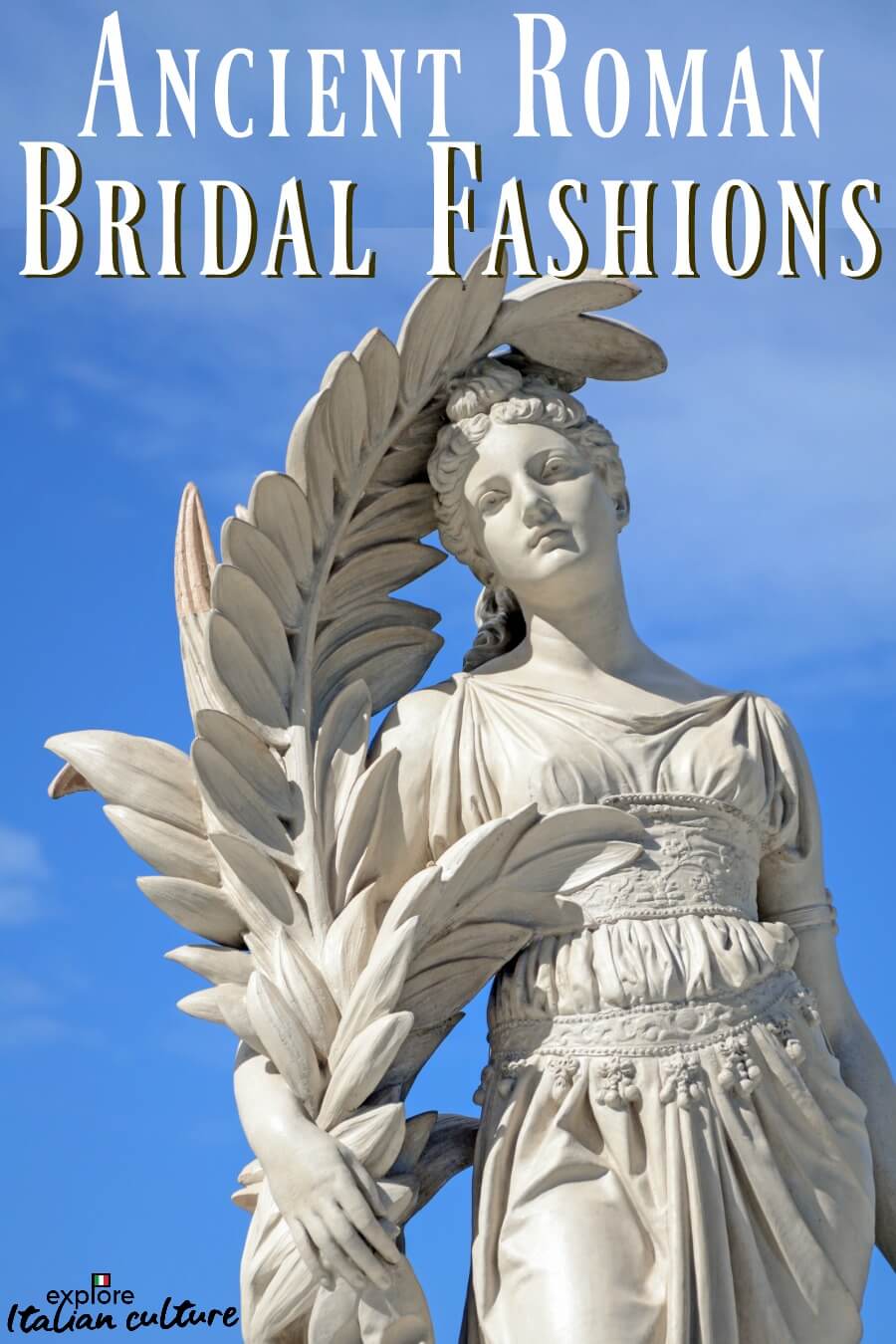Ancient Roman fashion for brides, and its influence on bridal etiquette today.
Ancient Roman fashion set the standard for present day Italian culture, traditions and customs in weddings. Wedding etiquette in the Empire was not so very different from bridal etiquette today.
If you're planning an Italian-themed wedding or getting married in Italy and want to include some ancient Italian culture in your plans, this page will tell you how the style of women in ancient Rome can add sophistication to your own elegant wedding.
Ancient bridal etiquette: the bride's wedding day preparations.
Most rituals women in ancient Rome had to go through on their wedding morning reflected everyone's expectations that she would be pure, dutiful and obedient.
According to ancient Italian engagement culture and traditions, once the betrothal formalities were over, the Roman bride-to-be never had opportunity for partying. Instead, the accepted custom for her was some pampering on the morning of her wedding.
So right at the start of the day, bridal etiquette in ancient times was to take a fragranced bath in her parents' home. She would be attended by her mother and female friends. The aim was to wash away evil influences and leave her smelling wholesome - and no doubt to share in gossip and the excitement of the approaching ceremony.
Then came the hair.

The bride and ancient Roman hairstyles.
The hairstyle and head dress were a focal point at ancient Roman weddings. Custom dictated that the bride had to rise early on the morning of the marriage. Her first task was to pick flowers from her parents' garden to weave a garland which would sit on top of her intricate hairstyle, and hold her veil in place.
Sound familiar?
Many modern brides still choose the flower garland, especially for younger bridesmaids. Just as in ancient Roman weddings, it's a symbol of innocence and purity.

The bridal hairstyle, known as the 'tutulus', was a very specific design and would be worn by no-one but brides. Her hair was divided into six locks using a spearhead, probably another symbol of expelling any remaining malevolent spirits.
The locks were then curled, and coiled on top of her head leaving a few tendrils around her face and neck.
The wedding veil, another symbol of the bride's submission to her husband, was always flame coloured and shrouded the bride from head to foot.
Sources vary as to whether it would cover the bride's face until the moment of marriage. There's some evidence that part of ancient traditions was that the veil did cover the face. It acted as a deterrent to evil spirits who would be unable to enter the bride through the shroud of a muslin veil.
Ancient Roman bridal fashion: the wedding dress.
 |
The fashion for women at weddings was fairly simple and the bride's dress was no exception. By today's standards it was very plain: a white or off-white one piece unfitted tunic. Made of a muslin-like material, it covered the bride from head to foot and was tied at the waist with a girdle.
The girdle was vital to bridal etiquette. It was tied by the bride's mother on her wedding morning as a sign to the world of the bride's purity, using the 'knot of Hercules' - Hercules being the guardian of married life - and could only be undone by her new husband on the wedding night.
It's likely that the origins of the contemporary saying "tying the knot" comes directly from this Roman tradition.
Ancient Roman fashion: bridal accessories.
Accessories, with the exception of her bouquet, do not seem to have been important to brides in ancient Rome.
Historical evidence suggests that her shoes, generally simple sandals, were dyed to match the veil. And although jewellery in ancient Rome could be quite elaborate, bridal wedding etiquette dictated that the bride wore no adornments apart from her engagement ring.
To do so was seen as detracting from the importance of the ring.
To this day, Italian brides have tended to maintain that tradition, or at least not to wear extravagant jewellery.
The bride's look was completed with a bouquet of herbs which, like her head-dress, she would have picked herself.
Although some think the need to wear flowers and carry herbs was an attempt to smother the smell of everyday ancient Roman life, it is far more likely that they were chosen to represent fidelity and fertility.
The bouquet often included marjoram symbolising love, honour and joy; rosemary for fidelity and lavender for devotion; sage for a long life; myrtle for fertility and purity.
Translating ancient Roman fashion into today's Italian culture.
So - what should you be thinking about if you want to use some of the traditions of ancient Roman bridal etiquette in your own ceremony?
Here are our suggestions :
Think about dressing young bridesmaids' or flower girls' hair in garlands of flowers. Roses were a favourite amongst women in ancient Rome, as were iris, violets, poppies and wildflowers.
Put the same flowers in your bouquet and ask your florist to add some fragrant herbs. The ancient Romans favoured lavender, thyme and rosemary, all of which are readily available today. Grow your own, if possible!
Give yourself enough time to have a relaxing bath (probably without your mother in attendance!) on your wedding morning. Add some fragrance to it - either a floral based perfume to complement your bouquet, or the bath oil of your favourite perfume.
 |
| A modern take on ancient Roman wedding dresses. Courtesy of Maggie Sotero. |
Wear your hair in an up-do, leaving tiny tendrils to frame your face.
Follow ancient Roman fashion by keeping your wedding dress simple and stylish. Ivory or white, off the shoulder, toga style, and if possible tied around the bust, waist or hips would work.
If you intend to wear a veil, make it a full length one. Unless you want to recreate Roman bridal etiquette exactly, flame-coloured is probably not an option you'd want to follow!
If you want to wear jewellery, keep it simple and unobtrusive. Pendant earrings and necklaces were favourite pieces of jewellery in ancient Rome.
Want to know more about life in ancient Rome? Here's where to start.
Ancient Roman weddings : the rest of the story








